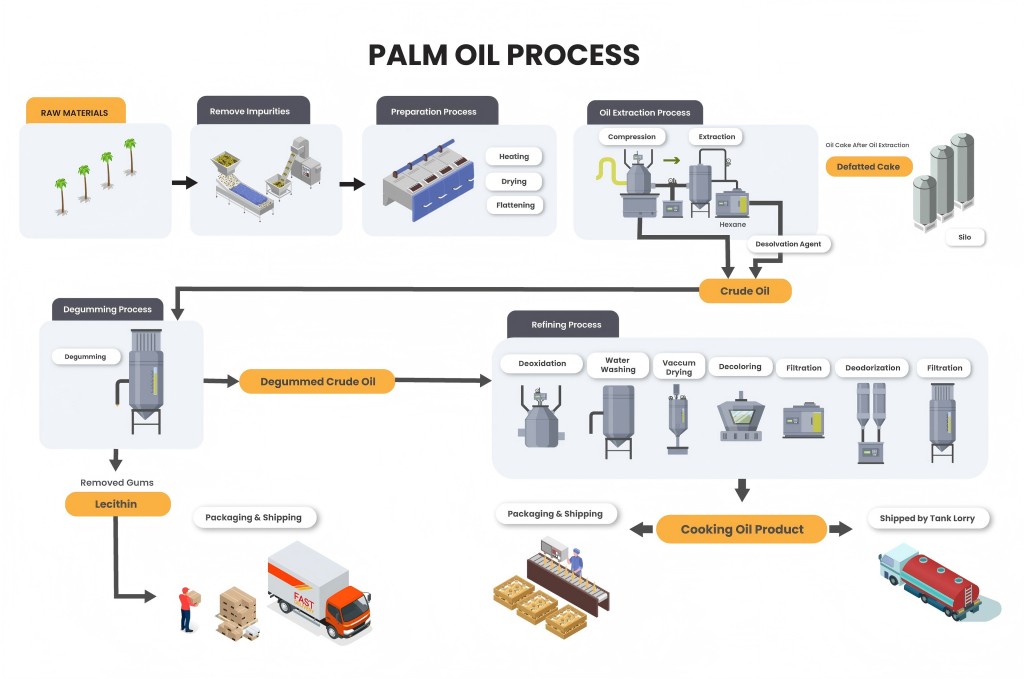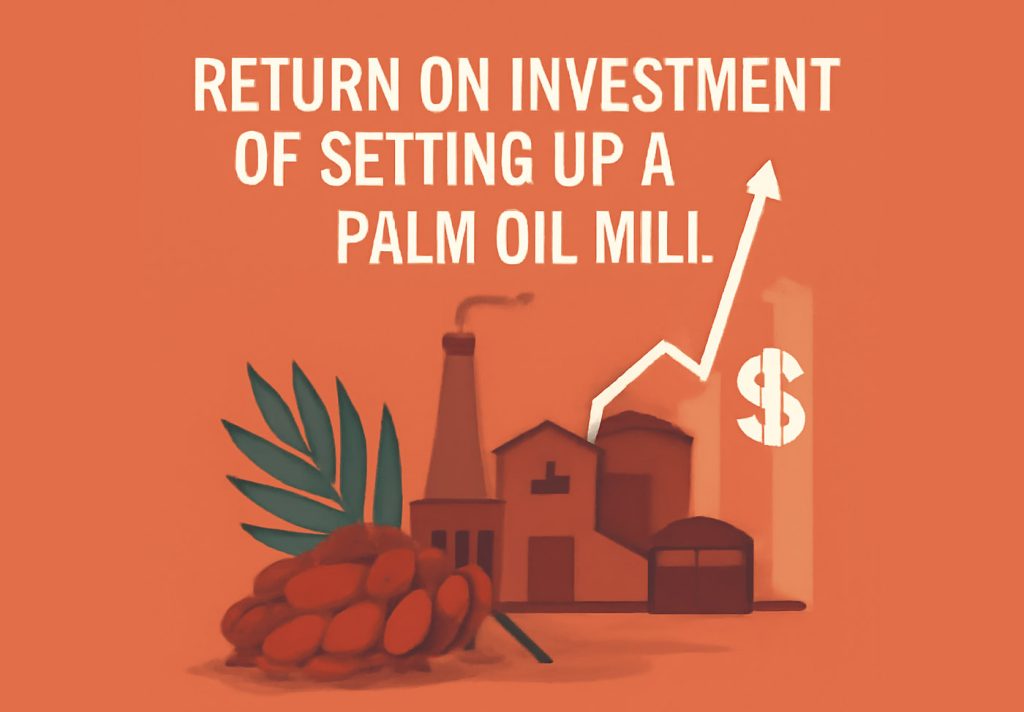Setting up a palm oil mill is a significant investment, especially in regions like Southeast Asia, Africa, and South America, where oil palm is a staple crop. With rising global demand for edible oils and biofuels, palm oil remains highly profitable. This article explores the financial, operational, and strategic factors that influence ROI and how investors can maximize their returns.
The Growing Market Demand for Palm Oil
Palm oil is used in a wide range of industries—from food processing (cooking oil, margarine, snacks) to cosmetics, pharmaceuticals, and bioenergy. The global palm oil market was valued at over $60 billion in 2024 and is projected to continue growing due to its cost-effectiveness and high yield per hectare compared to other vegetable oils. Countries such as Indonesia and Malaysia dominate production, but African nations like Nigeria and Ghana are catching up, driven by government support and growing local demand.
The allure of investing in a palm oil mill is supported by this rising demand. Whether you’re an agribusiness investor, a cooperative, or a private entrepreneur, entering this market can deliver strong financial rewards, provided the investment is well-planned.

Key Cost Components of a Palm Oil Mill Setup
Understanding the capital and operational costs is essential for estimating ROI. The major cost components include:
1. Land Acquisition
The mill’s size and location affect costs. In Africa or Southeast Asia, land prices vary widely. For a small- to medium-sized mill (1–10 tons/hour), investors may require 5–10 hectares for buildings, roads, and storage.
2. Machinery and Equipment
The most substantial upfront cost includes:
- Threshers
- Sterilizers
- Digesters and Presses
- Clarification Systems
- Boilers and Generators
- Effluent treatment plants
Prices range from $150,000 to over $1 million, depending on capacity and automation level.
3. Construction and Infrastructure
Buildings, roads, drainage systems, electricity, and water supply are necessary infrastructure costs that can amount to 20–30% of the total investment.
4. Labor and Operational Costs
A standard mill requires machine operators, maintenance personnel, lab technicians, and administrative staff. Labor-intensive setups will cost more monthly but are often more viable in regions with high unemployment and low labor costs.
5. Raw Material Supply
A mill without access to fresh fruit bunches (FFBs) will fail. Costs may include maintaining your own plantations or contracts with out-grower farmers. Ensuring a consistent FFB supply is vital for achieving steady output.
Revenue Streams and Profit Drivers
Palm oil mills generate revenue from several products:
Crude Palm Oil (CPO)
The primary product, sold to refineries. Yield ranges from 18% to 24% of FFB input, depending on quality and mill efficiency.
Palm Kernel Oil (PKO) and Palm Kernel Cake (PKC)
By-products extracted from kernels are valuable in animal feed, cosmetics, and biodiesel industries.
Biomass and Energy
Empty fruit bunches, palm fiber, and shells can be used to generate steam and electricity, reducing operational energy costs, or sold as biomass fuel.
Carbon Credits
Sustainable mills that reduce methane emissions or use renewable energy can qualify for carbon trading programs or green financing.
ROI Benchmarks by Mill Size
| Mill Capacity | Estimated Setup Cost | Net Annual Profit | ROI Estimate | Payback Period |
| Small (1–3 tons/hr) | $500K – $1M | $100K – $300K | 20–30% | 3–5 years |
| Medium (4–10 tons/hr) | $1M – $3M | $400K – $1M | 30–50% | 2–3 years |
| Large (>10 tons/hr) | $3M – $ 10 M+ | $1M – $ 3 M+ | 40–60%+ | 1.5–3 years |
ROI Calculation: A Hypothetical Scenario
Let’s take a hypothetical small-scale mill producing 5 tons/hour of FFB:
| Parameter | Value |
| Daily FFB Processing Capacity | 40 tons |
| Average CPO Yield | 22% |
| Daily CPO Output | 8.8 tons |
| CPO Price (2025 average) | $800 per ton |
| Daily CPO Revenue | $7,040 |
| Annual Working Days | 300 |
| Annual Revenue | $2,112,000 |
| Operating Costs/year (estimated) | $900,000 |
| Depreciation and Maintenance/year | $150,000 |
| Net Annual Profit | $1,062,000 |
| Initial Setup Cost | $2,500,000 |
| Simple ROI (Net Profit / Investment) | 42.5% |
| Payback Period | ~2.4 years |
Factors That Influence ROI
Mill Size and Efficiency
Larger mills benefit from economies of scale but require higher capital. Small mills have lower setup costs and quicker payback, making them suitable for cooperatives or rural investors.
Automation Level
Automated mills reduce labor costs, improve extraction rates, and enhance consistency. However, they require skilled labor and higher upfront costs.
Proximity to Plantations
Closer proximity reduces transport costs and ensures fresher FFBs, leading to higher oil yields.
Government Policies
Import tariffs, export incentives, tax holidays, and environmental regulations significantly impact profitability. Many countries support domestic mills to reduce reliance on imported oil.
Market Access and Product Diversification
Direct access to export markets, certified sustainable palm oil (CSPO) premiums, and value-added products like refined oils or soaps can dramatically improve ROI.
Risks and Mitigation Strategies
Risk 1: FFB Supply Instability
Mitigation: Sign long-term supply agreements; consider vertical integration by developing your own plantations.
Risk 2: Market Price Fluctuations
Mitigation: Use futures contracts or diversify product streams.
Risk 3: Operational Downtime
Mitigation: Invest in quality machinery and establish preventive maintenance routines.
Risk 4: Environmental Compliance
Mitigation: Invest in effluent treatment and emissions control systems to meet regulations and attract green investors.
Social and Environmental ROI
Beyond financial returns, investors should consider social and environmental ROI, especially in developing regions where palm oil is a community-based commodity.
Local Employment and Community Impact
A palm oil mill can employ dozens to hundreds of workers directly and indirectly. This boosts local economies, creates rural livelihoods, and reduces poverty, factors increasingly valued by ESG (Environmental, Social, Governance) investors.
Waste Management and Environmental Stewardship
By investing in sustainable practices, such as biogas capture from palm oil mill effluent (POME), composting empty fruit bunches, or water recycling, investors can enhance their brand image and align with global sustainability goals. These practices often qualify for tax incentives and carbon credits, adding to long-term profitability.
Certification and Market Access
Gaining certifications like RSPO, ISCC (International Sustainability and Carbon Certification), or Organic can open access to premium international markets, increasing revenue by 10–20%. Sustainable practices also reduce the risk of regulatory fines or international trade barriers.
Sustainability and Long-Term ROI
Sustainability is becoming a key driver of ROI. Mills aligned with RSPO (Roundtable on Sustainable Palm Oil) certification can gain access to international markets, attract green investment funds, and command premium prices.
Furthermore, using circular economy principles—such as converting waste into biogas or compost—can reduce operational costs and generate new income sources.
Conclusion
The return on investment for a palm oil mill is highly attractive, with ROIs ranging from 30% to over 50% and payback periods as short as two years. By using modern technologies, controlling the supply chain, adhering to sustainability standards, and improving efficiency, investors can turn a palm oil mill into a profitable long-term asset. Whether you’re an investor, cooperative, or entrepreneur, the palm oil sector offers significant potential for growth and sustainable profits with smart investments.


